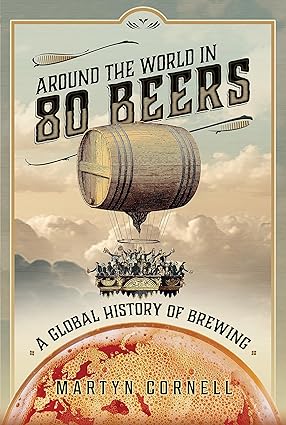In the introduction to “Hopped Up,” author Jeffrey Pilcher begins, “In 2009, the PureTravel website imagined a United Nations of brewing on a map titled ‘Around the World in 80 Beers.’” I’m going to pretend that instead he referred to another book about beer new to the market, Martyn Cornell’s “Around the World in 80 Beers.” Both offer a “global history of brewing,” but, no surprise, in different ways.
 First up, “Hopped Up.” Pilcher uses the “Around the World” map, which features each country’s most iconic brand, to illustrate the ubiquity of pale lager. In his words:
First up, “Hopped Up.” Pilcher uses the “Around the World” map, which features each country’s most iconic brand, to illustrate the ubiquity of pale lager. In his words:
– In narrating the history of beer’s commodification and the triumph of pale lager, “Hopped Up” takes a global perspective.
– “Hopped Up” explores the social patterns of gender, race, and class that shaped the commodification of beer.
– The book examines taste as an agent in shaping the commodification of beer, both as an independent sensory experience and as an instrument of social distinction.
– The book examines taste as an agent in shaping the commodification of beer, both as an independent sensory experience and as an instrument of social distinction.
– “Hopped Up” shows that craft styles such as India Pale Ale, London porter, and even Belgian sours were likewise products of industrial modernity. Although microbrewers have imagined themselves as countercultural and anti- capitalist, the quest for profit and expansion has often supplanted the original communitarian focus on local pubs and homebrewing. The resulting synthesis of commodity and craft provided a capitalist beer for the twenty-first century.
That — a history that begins from the get-go and spans the globe — is a lot to pack into 249 pages. Pilcher is a food historian, whose previous book was “Planet Taco: A Global History of Mexican Food.” He collected information found in 10 archival resources and hundreds of books and articles. This is the first book I’ve read that draws from the Michael Jackson Collection at Oxford Brookes University.
It is an academic tome. That’s not stated as a criticism, but as a fact. It is a resource that has almost 50 pages of notes 9after 249 pages of prose) that, for those interested, lead to much more to read. There is a theme that runs throughout, and a point of view evident in the list above. However, there is no room for stories such as the time Sam Calagione rigged up a plastic bucket and vibrating electronic football game he bought at the Salvation Army to add hops at regular intervals for the first batch of 60 Minute IPA he brewed at Dogfish Head.
 “Around the World in 80 Beers” does not have notes, an index or a bibliography, but you can trust it was researched at least as meticulously. In Cornell’s words:
“Around the World in 80 Beers” does not have notes, an index or a bibliography, but you can trust it was researched at least as meticulously. In Cornell’s words:
“The idea of ATWI80B — and I believe it’s a unique one — is that each chapter starts by looking at one contemporary beer, across more than 40 different countries, from Norway to New Zealand and China to Brazil, and uses that beer as a springboard to talk about the history of the beer style that beer represents, the history of brewing in that country and the history of that brewery.”
For instance, in writing about Sierra Nevada Pale Ale, which he calls “the most influential beer since Josef Groll unveiled his pale lager in the Czech town of Pilsen 138 years earlier,” he discusses the evolution of modern hops and the importance of Cascade. He even introduces readers to 4-mercapto-4-methylpentan-2-one.
Regular readers of Cornell’s blog, Zythophile, will recognize he’s been there, done that when selecting beers to profile. That includes four from South America, which is really big and where exciting beer things are happening that deserve more attention.
One of them is from Ecuador, and was one of the best beers I tasted in 2022. As the founders of Cerveceria Qutieña point out, Chicha Vieja is “a modern way to tell the story of who we are” as well as the one about the ancient drink chicha. When we shared a bottle at the brewery, “Farmhouse Ales” author Phil Markowski said it would have been easy to imagine we were in Belgium drinking gueuze. I concurred.
Alles Blau Catharina Sour is equally interesting, but in a different way. Catharina Sour is a modern invention, one that blends the German heritage of Blumenau, Brazil, with the astonishing range of unique fruits found in the region. The style is a reminder that what we call beer is always evolving, and that what begins as local can end up global. The best beer we had last month at Galway Bay Brewing in Ireland was a Catharina Sour.